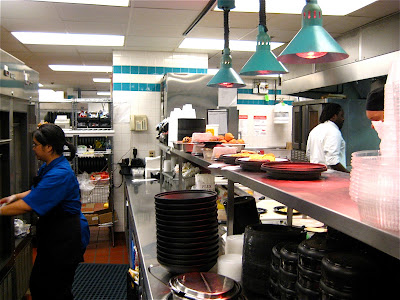The Tufts Medical Center kitchen! For the dietetic internship I am required to learn production and management skills in a large food service setting. So for the past three weeks I have been hanging out in the kitchen listening to stories [and songs!] from the cooks, exchanging meal trays and friendly banter with the kitchen staff, walking the hospital floors with the meal passers, and observing the inner workings of the kitchen management. Tufts has contracted its hospitality service with Aramark, and like many hospitals it has set up a "room-service" infrastructure in order to give provide high quality individualized meals for their patients.
View of the trayline from behind. I was usually stationed at the very end on the right, and would check the meals before they went to the hospital floor.
I was really nervous about taking pictures in the kitchen. I wouldn't survive as a stealth photographer.
What did I do in the hospital kitchen?Under the supervision of the Assistant Director of Patient Services (who is also a Registered Dietitian), I have been learning about management roles in the context of large-scale food production.
- Help assemble and check meals on the trayline.
- Performance Improvement measurements in the kitchen (accuracy of meal trays, timing of room service delivery, temperature compliance of the food, protocol compliance of the meal passer employees).
- Brief research report on sustainability in foodservice.
- Observed the call center, where patients place their room service orders.
- Sanitation and safety audits in the kitchen.
- Test tray...testing for correct food temperatures once the meal reaches the patient's room.
- Paperwork for payroll.
- Observe the head chef in food purchasing and inventory.
- Attend various meeting with my manager.
- Inservice with the cooks. The topic was the gluten-free diet.
Tasty [and Sustainable] Links to Share
While researching the concept of sustainability within foodservice institutions, I came across several informative resources. Just want to share! Enjoy.
Healthy Land, Healthy Food, and Healthy Eaters: Dietitians Cultivating Sustainable Food Systems. By Angie Tagtow and Alison Harmon. Published 2009. Eight page handout explaining the dietitian's role in approaching food, nutrition and health from an ecological standpoint.
The Food Climate Relationship: The Registered Dietitians' Balanced Approach to Postivie Change. Published 2010. Handout published by Health Care Without Harm and Hunger and Environmental Nutrition (dietetic practice group of the American Dietetic Association).
Buyer's Guide for Sustainable Seafood. By the Monterey Bay Aquarium, as part of their SeafoodWatch program. They characterize fish by "Best Choice," "Good Alternative" and "Avoid." Also check out their archives of Sustainable Seafood Recipes for amazing dishes like "Grilled Oysters with Wasabi and Miso." Ouch...that sounds good.
Gotta love those homemade choc chip cookies.
The kitchen feeds me well! I have hardly gone grocery shopping in 3 weeks.
Next week I start clinical rotations with the dietitians on the adult inpatient floors! Cardiology is first up. It's time for real patient contact, and I am so nervous. Any tips for me??
Bye bye!
Rachel
PS- My last day in the kitchen is Friday. I won't miss the hairnets, but I will sincerely miss the kitchen family. Thank you for welcoming me into your loud and crazy, but friendly world!





6 comments:
Oh, food service. I definitely do not miss it. :-) Clinical was so much more interesting and exciting to me. I think remembering that patients are just people helps to calm nerves a lot. My dad spent quite a bit of time in the hospital as a liver transplant patient, and I always try to think of how he would like to be treated when I interact with patients. My favorite part of clinical was talking with patients and families and feeling like I was truly making a difference in their care.
thanks Emily. I always appreciate your insights and encouragement!
Great design on the worksheet! I definitely appreciate the nice layout and graphics. So excited to hear about the clinical rotation. I have to say I totally had a dream about EN and TPN last night... weird.
Great post. It almost, ALMOST, makes me miss the kitchen and food service. I do not miss early mornings and I do not miss doing dishes.
As for clinical. One of my last units was a CVTU (cardiovascular thoracic unit) and I think you will enjoy cardiology. One thing to remember for starting our with patient contact and interviews is to use your eyes, not just your ears. Really look at the patient. Do you see wasting? Do they have poor dentition? Ask them the right questions, making sure you have read the medical history first. Make sure you are aware of any cultural differences. Since you did food service already you should already know the list of supplement products your facility carries. Good luck. I am so missing clinical right now!
I forgot to mention that I think you did a great job on the inservice handout.
Great handout Rachel! I have to admit I much prefer clinical over food service.
After five years of clinical dietetics, patient contact gets much easier with practice. I find some of my interns get so nervous during patient interviews that they often forget to obtain valuable nutritional history info from the patient/family. Definitely remember to relax and that the patient is a person just like you; but also remember you are in their room for a reason and you have a job to do!
Post a Comment